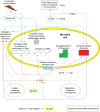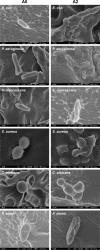Antimicrobial hydrogels: promising materials for medical application
- PMID: 29695904
- PMCID: PMC5905846
- DOI: 10.2147/IJN.S154748
Antimicrobial hydrogels: promising materials for medical application
Abstract
The rapid emergence of antibiotic resistance in pathogenic microbes is becoming an imminent global public health problem. Local application of antibiotics might be a solution. In local application, materials need to act as the drug delivery system. The drug delivery system should be biodegradable and prolonged antibacterial effect should be provided to satisfy clinical demand. Hydrogel is a promising material for local antibacterial application. Hydrogel refers to a kind of biomaterial synthesized by a water-soluble natural polymer or a synthesized polymer, which turns into gel according to the change in different signals such as temperature, ionic strength, pH, ultraviolet exposure etc. Because of its high hydrophilicity, unique three-dimensional network, fine biocompatibility and cell adhesion, hydrogel is one of the suitable biomaterials for drug delivery in antimicrobial areas. In this review, studies from the past 5 years were reviewed, and several types of antimicrobial hydrogels according to different ingredients, different preparations, different antimicrobial mechanisms, different antimicrobial agents they contained and different applications, were summarized. The hydrogels loaded with metal nanoparticles as a potential method to solve antibiotic resistance were highlighted. Finally, future prospects of development and application of antimicrobial hydrogels are suggested.
Keywords: antibiotics; drug delivery; hydrogels; infection; nanomaterials; nanoparticles.
Conflict of interest statement
Disclosure The authors report no conflicts of interest in this work.
Figures









References
-
- Ng VW, Chan JM, Sardon H, et al. Antimicrobial hydrogels: a new weapon in the arsenal against multidrug-resistant infections. Adv Drug Deliv Rev. 2014;78:46–62. - PubMed
-
- Global Burden of Disease Study 2013 Collaborators Global, regional, and national incidence, prevalence, and years lived with disability for 301 acute and chronic diseases and injuries in 188 countries, 1990–2013: a systematic analysis for the Global Burden of Disease Study 2013. Lancet. 2015;386(9995):743–800. - PMC - PubMed
-
- García-Barrasa J, López-de-Luzuriaga JM, Monge M. Silver nanoparticles: synthesis through chemical methods in solution and biomedical applications. Cent Eur J Chem. 2010;9(1):7–19.
-
- Aoki W, Kuroda K, Ueda M. Next generation of antimicrobial peptides as molecular targeted medicines. J Biosci Bioeng. 2012;114(4):365–370. - PubMed
Publication types
MeSH terms
Substances
LinkOut - more resources
Full Text Sources
Other Literature Sources
Miscellaneous

